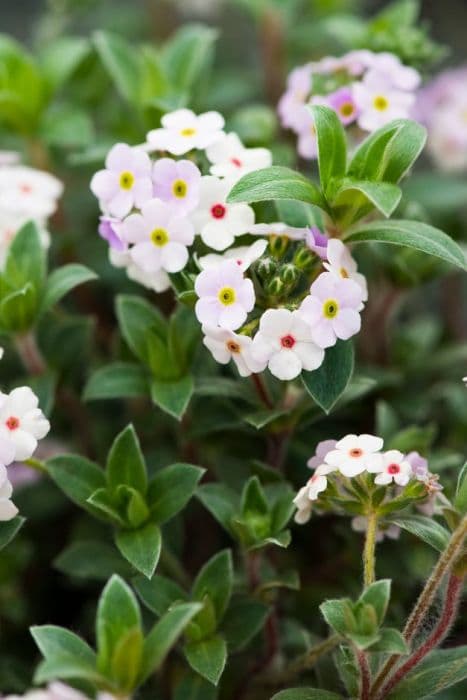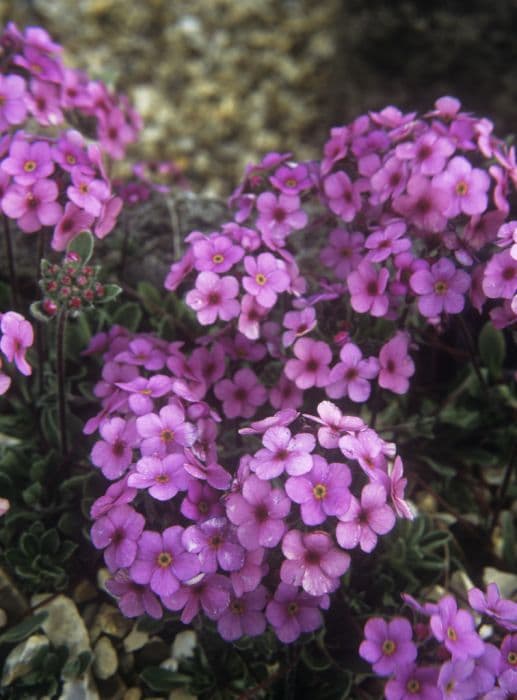Auricula Primula auricula hort. 'Cambodunum' (Au/a)

ABOUT
Primula auricula, commonly known as auricula, 'Cambodunum' is a captivating plant notable for its distinctive features. The auricula showcases rosettes composed of soft, lush green leaves which provide a wonderful backdrop for the true stars of the show – the flowers. These blossoms are typically a spectacle of color, often presenting a rich, velvety texture. The 'Cambodunum' variety shines with its unique and strikingly patterned petals that can come in a spectrum of colors, from deep purples and maroons to bright yellows and pastels, often adorned with a vibrant center or eye that contrasts with the rest of the petals. The petals might exhibit a dramatic, contrasting edge or piping, contributing to the ornate and refined appearance of the plant. Each flower head is held aloft by a sturdy stem, which elevates the blooms, ensuring they catch the eye. The arrangement of the flowers is in umbels, creating a cluster of individual blossoms that together form a stunning display. When in bloom, the auricula 'Cambodunum' becomes a showpiece within the garden or when carefully cultivated and displayed at flower shows. Its beauty lies not only in its floral display but also in the overall composition and structure of the plant, which possesses an admirable form as well as a charming, painterly aspect to its flowers.
About this plant
 Names
NamesFamily
Primulaceae.
Synonyms
Bear's Ear, Mountain Cowslip, Auricula.
Common names
Primula auricula 'Cambodunum'.
 Toxicity
ToxicityTo humans
Primula auricula, more commonly known as Bear's ear, generally has low toxicity to humans. While not considered highly toxic, ingestion of parts of the plant can cause mild symptoms such as nausea, vomiting, or diarrhea if consumed in significant amounts. Contact with the plant's sap may also cause skin irritation or a rash in some individuals due to the presence of Primin, a known skin irritant.
To pets
Bear's ear, or Primula auricula, is also considered to have low toxicity to pets. Similarly to humans, ingestion might result in mild gastrointestinal upset, including symptoms like vomiting or diarrhea. Additionally, if pets come into contact with the sap, they could experience skin irritation. It is advisable to prevent pets from ingesting the plant and to consult a veterinarian if any adverse reactions occur.
 Characteristics
CharacteristicsLife cycle
Perennials
Foliage type
Evergreen
Color of leaves
Green
Flower color
Varies
Height
6 inches (15 cm)
Spread
8 inches (20 cm)
Plant type
Herb
Hardiness zones
5
Native area
Europe
Benefits
 General Benefits
General Benefits- Ornamental value: Primula auricula, commonly known as Auricula, is prized for its colorful and unique flowers that can enhance the visual appeal of gardens and landscapes.
- Ease of care: Auriculas are relatively low-maintenance, suitable for gardeners of all skill levels.
- Long blooming period: Auriculas produce flowers from early spring to late spring, providing a long period of visual interest.
- Attracts pollinators: The vibrant flowers of Auriculas can attract beneficial pollinators such as bees and butterflies to the garden.
- Versatility: Auriculas can be grown in a variety of settings, including borders, rockeries, and containers, offering flexibility for garden design.
- Propagates easily: Auriculas can be propagated through division or from seed, allowing gardeners to expand their collection or share with others.
 Medical Properties
Medical PropertiesThis plant is not used for medical purposes.
 Air-purifying Qualities
Air-purifying QualitiesThis plant is not specifically known for air purifying qualities.
 Other Uses
Other Uses- The leaves of the Auricula can be used in floral arrangements to add a unique texture or colorful backdrop to other flowers due to their thick, sometimes farinose (powdery) appearance.
- Auricula flowers are edible and can be used as decorative, delicate additions to salads or as garnishes on desserts and drinks for a touch of elegance.
- The low-growing habit and attractive foliage of Auriculas make them suitable for underplanting larger species in container gardens, adding visual interest and ground cover.
- Auricula flowers can be pressed and used in craft projects such as homemade greeting cards, bookmarks, or framed botanical art.
- The contrasting colors of Auricula flowers can be used by photographers and artists as subjects or inspiration for artistic creations due to their vibrant hues and intricate patterns.
- Auriculas can serve as a living paint palette in garden design, with their multitude of colors providing inspiration for color schemes in landscape design or interior decor.
- In mild climates, they can be planted in cracks and crevices of rock gardens or stone walls, where their roots can establish in the shallow soil, adding charm and color to hardscapes.
- The show varieties of Auriculas, with their unique and elaborate flowers, are often grown for competitive showing in Auricula theaters—a tradition dating back to the Victorian era.
- Theater-style display stands for Auriculas can be employed not just for the flowers themselves but also as a way to exhibit similarly sized and shaped collectibles or succulents in a tiered fashion.
- The hardiness of some Auricula varieties allows them to be planted in alpine troughs or cold frames, simulating their native mountainous habitats and providing year-round interest in a miniature landscape.
Interesting Facts
 Feng Shui
Feng ShuiThe Auricula is not used in Feng Shui practice.
 Zodiac Sign Compitability
Zodiac Sign CompitabilityThe Auricula is not used in astrology practice.
 Plant Symbolism
Plant Symbolism- Unique Beauty: With its bold, often contrasting colors and unique shape, the Auricula, commonly known as Bear's Ear, symbolizes distinctive beauty that stands out.
- Modesty: Despite its striking appearance, the modest size of the Auricula can represent humility and understated elegance.
- Precariousness: Because Auriculas often grow in alpine or rocky areas, they can symbolize the fragile balance of life and the ability to thrive in challenging conditions.
- Patience: As a plant that can take several years to flower from seed, Auriculas represent patience and the reward of waiting for something truly special.
- Pride: In the language of flowers, Auriculas can represent pride, perhaps due to their regal bearing and the pride taken by growers in cultivating particularly beautiful specimens.
- Endurance: The Auricula's ability to survive and bloom in cold mountain climates is emblematic of endurance and resilience in the face of hardship.
 Water
WaterAuriculas, commonly known as bear's ear, require consistent moisture but should not be left waterlogged. Water the plants thoroughly whenever the top inch of soil begins to feel dry, which may be once or twice a week depending on climate and indoor conditions. It’s important to use room-temperature water gently at the base of the plant, avoiding the foliage which can promote fungal diseases. Aim for an average of about 1 gallon of water per week, adjusting for particularly hot, dry, or humid conditions. During dormant periods in the winter, reduce watering significantly to prevent root rot.
 Light
LightAuriculas thrive in bright, indirect light. They do well in east or north-facing windows where they receive some morning sunlight and shade during the intense afternoon heat. Avoid direct, harsh sunlight especially in summer, as it can scorch the leaves of the plant. An ideal spot provides moderate light but shields the plant from the harshest midday sun.
 Temperature
TemperatureBear's ear prefers cooler temperatures, ideally between 50°F and 60°F, making it a great plant for cooler, climate-controlled homes. It can survive minimum temperatures of approximately 40°F but should be protected from frost. During the growing season, ensure it isn’t exposed to temperatures above 80°F for extended periods, as higher temperatures can stress the plant.
 Pruning
PruningPrune bear's ear to remove dead or fading flowers, which encourages the plant to produce more blooms. Perform this task immediately after flowering, typically in late spring or early summer. Trimming off dead leaves and spent flowers also prevents disease and keeps the plant looking tidy. Pruning is not typically required at any other times of the year unless to remove damaged foliage.
 Cleaning
CleaningAs needed
 Soil
SoilAuricula Primrose prefers a well-draining soil mix rich in organic matter, such as a blend of loam, peat, and perlite or grit. The ideal soil pH for Auricula Primrose should be slightly acidic to neutral, ranging from 6.0 to 7.0 for optimal growth.
 Repotting
RepottingAuricula Primrose should be repotted every couple of years or when it becomes root-bound. The best time to repot is after flowering, usually in late spring or early summer, to give the plant time to re-establish in its new pot before winter.
 Humidity & Misting
Humidity & MistingAuricula Primrose thrives in average to slightly above average humidity conditions. The best humidity level for this plant ranges from 40% to 60%, avoiding overly dry air, which may harm its delicate foliage and blooms.
 Suitable locations
Suitable locationsIndoor
Place in bright, indirect light with cool temps.
Outdoor
Partly shaded, sheltered spot with moist soil.
Hardiness zone
4-8 USDA
 Life cycle
Life cyclePrimula auricula, commonly known as "Auricula" or "Bear's Ear", begins its life cycle when seeds are sown in well-drained soil, typically during late winter or spring. After germination, the seedlings grow into rosettes of rounded or heart-shaped leaves, which steadily mature during the growing season. In its second year, Auricula typically blooms, producing clusters of vibrant, often fragrant flowers in various shades that arise on stalks from the center of the leaf rosettes. After pollination by insects, the flowers produce seed capsules that, once dried, release seeds to commence a new generation. The plant is perennial, with individual specimens potentially living for several years if divided and repotted as needed to prevent overcrowding and maintain health. During the winter or in periods of dormancy, the Auricula will die back, conserving energy in its roots before resuming growth in the following spring.
 Propogation
PropogationPropogation time
Spring
Propogation: The most popular method of propagation for Primula auricula, commonly known as Auricula Primrose, is through division. This should be done in late summer after the flowering period has ended. To propagate by division, carefully lift the clump from the ground using a garden fork or spade, ensuring minimal damage to the roots. Gently tease the plant apart into smaller sections, each with a rosette of leaves and its own root system. Replant the divisions immediately at the same depth they were growing before, spaced about 6 to 8 inches (15 to 20 centimeters) apart to allow for adequate air circulation and growth. Water the new plants thoroughly to help establish them. With proper care, these divisions will thrive and produce flowers in the following spring.









